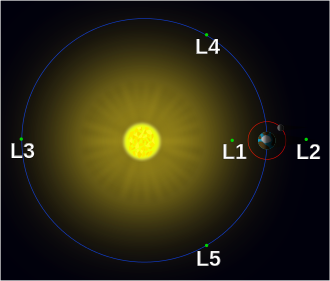Was hoping to watch the launch however it was cancelled due to high level winds over the flight parameters
EDIT: that was then, this is now.
The launch went off 24 hrs later, at around 6PM EDT Wednesday 2/11
The five Lagrangian points are labeled and defined as follows:
The L1 point lies on the line defined by the two large masses M1 and M2, and between them. It is the most intuitively understood of the Lagrangian points: the one where the gravitational attraction of M2 partially cancels M1's gravitational attraction.
Example: An object that orbits the Sun more closely than Earth would normally have a shorter orbital period than Earth, but that ignores the effect of Earth's own gravitational pull. If the object is directly between Earth and the Sun, then Earth's gravity weakens the force pulling the object towards the Sun, and therefore increases the orbital period of the object. The closer to Earth the object is, the greater this effect is. At the L1 point, the orbital period of the object becomes exactly equal to Earth's orbital period. L1 is about 1.5 million kilometers from Earth.[1]
EDIT: that was then, this is now.
The launch went off 24 hrs later, at around 6PM EDT Wednesday 2/11
DSCOVR will maintain the Nation’s solar wind observations, which are critical to maintaining the accuracy and lead time of NOAA’s space weather alerts and forecasts. DSCOVR is a partnership between NOAA, NASA and the U.S. Air Force (USAF) DSCOVR will succeed NASA’s Advanced Composition Explorer (ACE)
ACE is the only current satellite providing real-time time solar wind observations from the L1 orbit (Lagrangian point 1, approximately 1 million miles away from Earth), and it is well past its design life.
http://en.wikipedia.org/wiki/Lagrangian_point
Lagrange points in the Sun-Earth system (not to scale)
The L1 point lies on the line defined by the two large masses M1 and M2, and between them. It is the most intuitively understood of the Lagrangian points: the one where the gravitational attraction of M2 partially cancels M1's gravitational attraction.
Example: An object that orbits the Sun more closely than Earth would normally have a shorter orbital period than Earth, but that ignores the effect of Earth's own gravitational pull. If the object is directly between Earth and the Sun, then Earth's gravity weakens the force pulling the object towards the Sun, and therefore increases the orbital period of the object. The closer to Earth the object is, the greater this effect is. At the L1 point, the orbital period of the object becomes exactly equal to Earth's orbital period. L1 is about 1.5 million kilometers from Earth.[1]


No comments:
Post a Comment